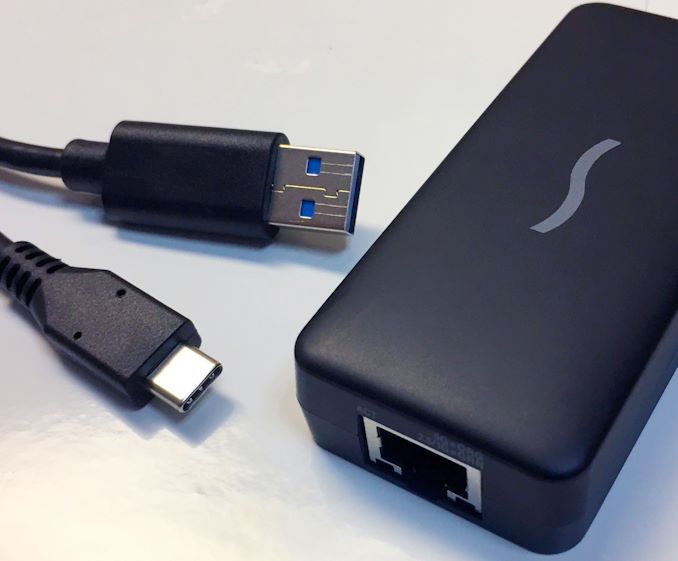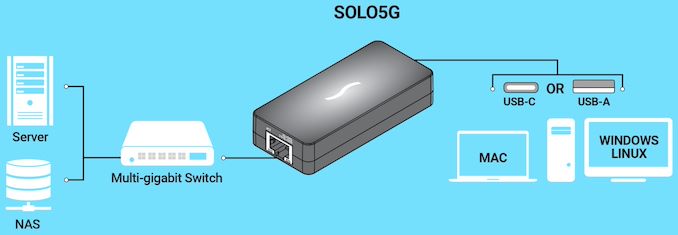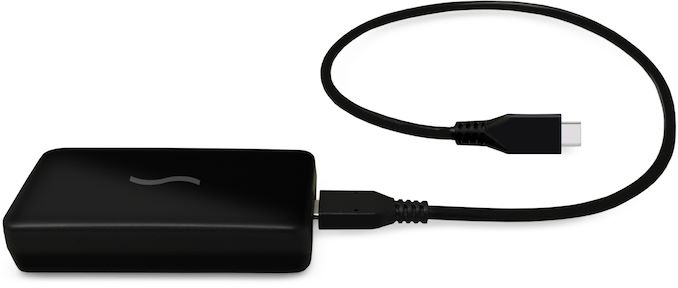Sonnet Unveils Solo5G: A USB-C to 5 GbE Network Adapter
by Anton Shilov on February 28, 2020 5:00 PM EST- Posted in
- Networking
- Aquantia
- USB-C
- NBASE-T
- 2.5GBase-T
- 5GBase-T
- Ethernet
- 10GbE
- AQC111U
- 2.5 GbE

Sonnet has started sales of its Solo5G, their first 5 Gigabit Ethernet USB-C dongle. Designed to quickly and easily add support for faster networking to any laptop or desktop with a USB interface, the device is compatible with all three of the major OSes.
Adoption of NBASE-T networks is proceeding slowly due to two reasons: expensive Multi-Gig Ethernet switches and sporadic support of NBASE-T by PCs. Fortunately, higher-end desktops as well as gaming laptops are finally getting native NBASE-T support, but when it comes to mainstream and ultra-thin machines, such support is a rare occurrence; so to gain Multi-Gig support they need external USB adapters. A couple of years ago Aquantia (an independent company back then) developed its AQtion AQC111U and AQtion AQC112U USB-to-Ethernet chips along with reference designs for USB 3.0 to 2.5GbE/5GbE adapters to simplify production of such devices.
Sonnet’s Solo5G is based on the Marvell AQC111U controller (since Aquantia is now a part of Marvell), allowing 5GbE support to be added to any PC with a USB port. The device supports 5GBASE-T, 2.5GBASE-T, 1000BASE-T, 100BASE-TX networks over Cat5e cables at up to 100 meters. The dongle also supports advanced LAN features such as flow control or 802.11p QoS and works like a typical network adapter, so a driver for an appropriate OS is required.
The Sonnet Solo5G comes bundled with 0.5-meter USB-C to USB-C and USB-C to USB-A cables to maintain compatibility with new USB-C and legacy USB-A-enabled computers. As for portability, the dongle weighs 70 grams, so it should be easy to carry around.
The Solo5G USB-C to 5 GbE adapter is available now directly from the company at an MSRP of $79.99, which is not particularly cheap, but which is affordable enough to add NBASE-T capabilities to a PC without breaking the bank.
Related Reading:
- Club 3D Launches 2.5 GbE USB Type-A & USB Type-C Dongles
- Aquantia Multi-Gig: Single Chip USB 3.0 to 5G/2.5G Dongles Coming Soon
- AKiTiO’s Thunder3 10G Adapter Now Available: TB3-to-10GbE for Sub-$300
- EnGenius Reveals ‘Affordable’ Multi-Gig Switches with PoE: 8 2.5GBASE-T and 4 10GbE SFP+ Ports
Source: Sonnet













5 Comments
View All Comments
GreenReaper - Friday, February 28, 2020 - link
Good choice for HP Microservers released with 2xUSB 3.0 and 2x1GbE if you need a little more later on.nicolaim - Friday, February 28, 2020 - link
Why is it so big?amb9800 - Friday, February 28, 2020 - link
Yeah it's oddly large. The QNAP QNA-UC5G1 has been around for a long time now and is much smaller, despite using the same chipset (AQC111U) at the same price point (~$79). One could imagine maybe the plastic body on the Sonnet needs more room for heat dissipation (the QNAP has a metal exterior), but at least in the QNAP, that chipset (unlike TB3 10 GbE NICs) doesn't produce all that much heat.tygrus - Saturday, February 29, 2020 - link
What is the impact of latency and USB overheads? It's a 5Gbps USB to host which allows slightly less than 5Gbps of network traffic plus the USB traffic to squeeze through at best. Adding another 125 microsecond to each end and the usual 40 to 125 microsecond network latency (NIC1->switch->NIC2->switch->NIC1) can start slowing down transactions. Waiting for confirmation/reply before sending next packet is very sensitive to overall latency. File transfers with large send & receive windows and multiple data streams fill the pipe better.cygnus1 - Sunday, March 1, 2020 - link
Consumer apps doing bulk transfers won't notice. I really don't think the use cases for a USB ethernet adapter include anything so latency sensitive that the USB overhead will be noticed. This is for moving large files a few times faster to/from a machine that only has a 1gb NIC.